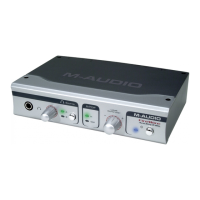Audiophile’s S/PDIF input. The following step-by-step instructions give you a basic
setup, and continue on to an advanced setup for adding and monitoring effects.
NOTE: In this example, we would leave the sync source selection in the control panel’s
hardware page set to internal. The outboard effects unit will get its clock from the
FireWire Audiophile’s S/PDIF Out, and therefore will lock to the internal clock. When the
effect unit returns to the S/PDIF Input, the S/PDIF Input should be in sync with the
internal clock.
1 Connect the FireWire Audiophile’s S/PDIF Out to the S/PDIF Input of your outboard
effects unit. In the FireWire Audiophile’s output page, click on the spdif out
channel’s main/aux switch so that it displays aux.
2 Since we’re going to be monitoring the effect from the S/PDIF input, we must assign the
spdif in channel in the FireWire Audiophile mixer page to a destination. Select 1/2 as the
destination, so that the effect is mixed in with other signals being monitored.
3 Set up your FireWire Audiophile to record with the analog inputs using the
instructions under the “Setting Up Your Record Levels” section, and either the ASIO
Direct Monitoring or Other Direct Monitoring sections.
4 Let’s assume that you are only using analog line in 1 for recording (maybe a bass synth on
channel 1). After you have set up a reasonable monitor level using the level fader on the
Mixer’s analog in and panned the channel (most likely center), add some level to the aux L
control. That signal is being sent to the aux output master channel, and then to the spdif out.
Since we’re adding an effect to a mono instrument, set the aux output master channel’s pan
knobs to <C>, or center panned.
As you play the synth, you should start to see level appear on the aux output master
channel as you add level to aux L control on the analog in. You should also start to see
level appearing at the input of your effects unit, and hear the effect level at the FireWire
Audiophile’s spdif in. You can make adjustments to the monitor level using the spdif in
channel’s level faders.
Now for the advanced setup. We’ve added an effect to the instrument that we’re
recording and direct monitoring. That’s fine for recording, but we might want to hear that
same effect when we are playing back—at least while the recording process is going on.
Once you’re done recording, you might want to disconnect the outboard effects unit,
reset your FireWire Audiophile Mixer, and then use the software plug-in effects from
within your audio software.
Here’s a suggestion for how to hear the same effect on the synth you are recording as
you hear when playing back the track and evaluating the performance.
1 Whichever track you are recording to, set that track’s output to Line Output 3 and 4.
2 In the FireWire Audiophile mixer, set the destination on sw rtn 3/4 to 1/2. Then,
match the level and the pan setting on sw rtn 3 to the analog in channel 1. Also,
match the level of the aux L controls for both of those channels.

